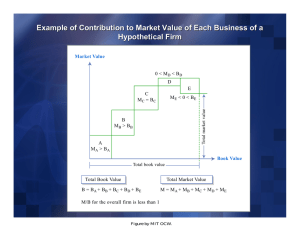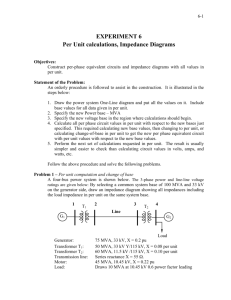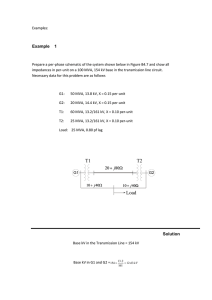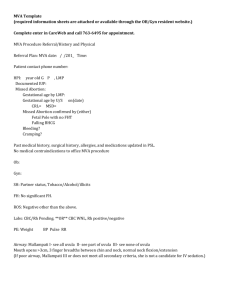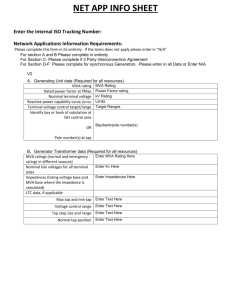MVA Method Short Circuit Calculation
advertisement
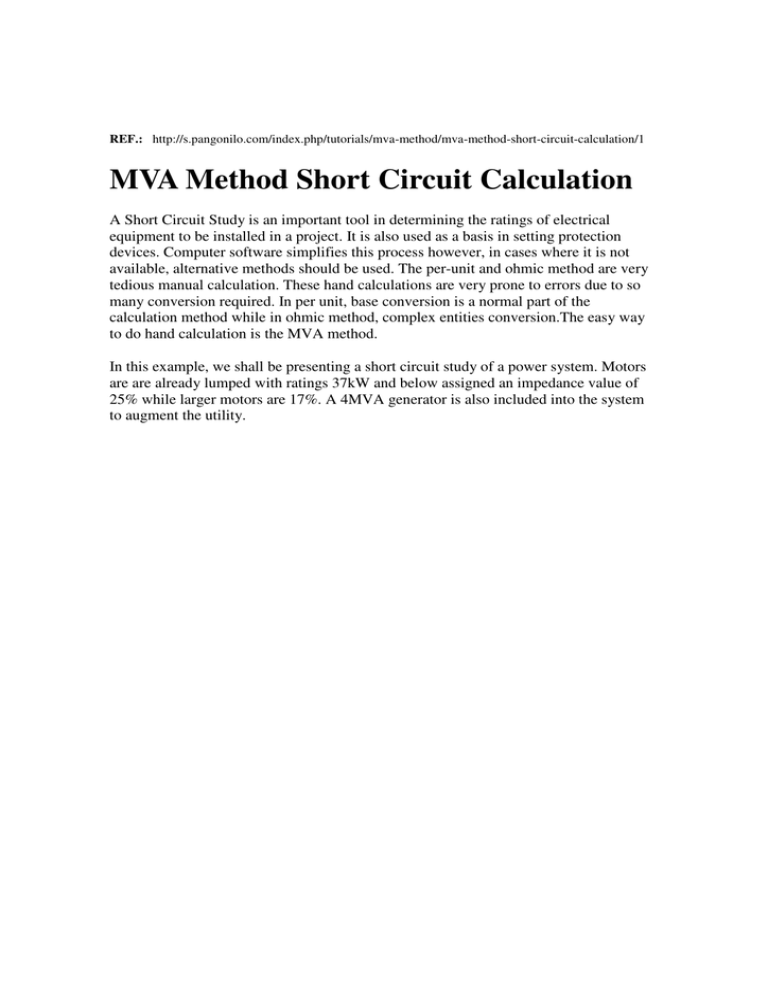
REF.: http://s.pangonilo.com/index.php/tutorials/mva-method/mva-method-short-circuit-calculation/1 MVA Method Short Circuit Calculation A Short Circuit Study is an important tool in determining the ratings of electrical equipment to be installed in a project. It is also used as a basis in setting protection devices. Computer software simplifies this process however, in cases where it is not available, alternative methods should be used. The per-unit and ohmic method are very tedious manual calculation. These hand calculations are very prone to errors due to so many conversion required. In per unit, base conversion is a normal part of the calculation method while in ohmic method, complex entities conversion.The easy way to do hand calculation is the MVA method. In this example, we shall be presenting a short circuit study of a power system. Motors are are already lumped with ratings 37kW and below assigned an impedance value of 25% while larger motors are 17%. A 4MVA generator is also included into the system to augment the utility. Figure 1 Utility: 33KV, 250 MVAsc Transformer 1: 10 MVA, 33/11KV, 9% Z 11KV Bus Generator: 3MVA, X"d = 0.113 Transformer 2: 5 MVA, 11/6.6KV, 7% Z Motor 1: 5MVA (Lumped), 17% Z 6.6KV Bus Transformer 3: 2 MVA, 6.6KV/400V, 6% Z Motor 3: 6.8 MVA (Lumped), 17% Z 400V Bus Motor 4: 300 KVA (Lumped), 17% Z Motor 5: 596 KVA (Lumped), 25% Z In the event of a short circuit, the sources of short circuit current are 1. Utility 2. Generators 3. Motors Static loads such as heaters and lighting do not contribute to short circuit. The "Equivalent MVA" are: Transformers and Motors Generators Cables and Reactors In Figure 1, I have calculated the Equivalent MVAs of each equipment, writing it below the ratings. Figure 2 Utility: MVAsc = 250MVA Transformer 1: MVAsc = 10 / 0.09 = 111.11 MVA 11KV Bus Generator: MVAsc = 3 / 0.113 = 35.4 MVA Transnformer 2: MVAsc = 5 / 0.07 = 71.43 MVA Motor 1: MVAsc = 5 / 0.17 = 29.41 MVA 6.6KV Bus Transformer 3: MVAsc = 2 / 0.06 = 33.33 MVA Motor 3: MVAsc = 6.8 / 0.17 = 40 MVA 400V Bus Motor 4: MVAsc = 0.3 / 0.17 = 1.76 MVA Motor 5: MVAsc = 0.596 / 0.25 = 2.38 MVA Figure 3 Upstream Contribution Starting from the utility, combine MVAs writing each one above the arrows. At Transformer 1: MVAsc @ 33KV = 250 MVA MVAsc @ 11KV = 1/ (1 / 250 + 1 /111.11) = 76.87 MVA At Transformer 2: MVAsc @ 11KV = 76.87 + 35.4 + 29.41 = 141.68 MVA MVAsc @ 6.6KV = 1/ (1 / 141.68 + 1 / 71.43) = 47.49 MVA At Transformer 3: MVAsc @ 6.6KV = 47.49 + 40 = 87.49 MVA MVAsc @ 400V = 1/ (1 / 87.49 + 1 / 33.33) = 24.14 MVA At 400V Motors Motor 3: MVAsc = 24.14 x 1.76 / ( 1.76 + 2.38 ) = 10.26 MVA Motor 4: MVAsc = 24.14 x 2.38 / ( 1.76 + 2.38 ) = 13.88 MVA Downstream Contribution Starting from the bottom (400V Bus), I combined MVAs writing each one below the arrows. In this bus, the motor contribution to short circuit is the sum of the MVAs of the lumped motors Motor 3 and Motor 4. At Transformer 3: MVAsc @ 400V = 1.76 + 2.38 = 4.14 MVA MVAsc @ 6.6KV = 1/ (1 / 4.14 + 1 / 33.33) = 3.68 MVA At Transformer 2: MVAsc @ 6.6KV = 3.68 + 40 = 43.68 MVA MVAsc @ 11KV = 1/ (1 / 43.68 + 1 / 71.43) = 27.11 MVA At Transformer 1: MVAsc @ 11KV = 27.11 + 29.41 + 35.4 = 91.92 MVA Note: Two downstream plus the generator contribution. MVAsc @ 33KV = 1/ (1 / 91.92 + 1 /111.11) = 50.3 MVA To determine the Faults Current at any bus on the power system, add the MVA values above and below the arrows. The sum should be the same on any branch. Example: 11 KV Bus: From Transformer 1: MVAsc = 76.87 + 91.92 = 168.79 MVA From Generator : MVAsc = 35.4 + 133.39 = 168.79 MVA From Transformer 2: MVAsc = 141.68 + 27.11 = 168.79MVA From Motor 1: MVAsc = 139.38 + 29.41 = 168.79 MVA This is a check that we have done the correct calculation. Ifault @ 11KV = 168.79 / (1.732 x 11) = 8.86 kA All we have done above are three phase faults, you may ask, how about single phase faults? For single phase faults, positive sequence, negative sequence and zero sequence impedances need to be calculated. If = 3 (I1 + I2 + I0) Examining the circuit in Figure 1, at the 400V Bus, on Transformer 3 contributes to the zero sequence current. For transformers, the negative sequence and zero sequence impedance are equal to the positive sequence impedance. Z1 = Z2 = Z0 or MVA1 = MVA2 = MVA0 At the 400V Bus 1 / MVAsc =1/3 (1 / MVAsc1 + 1 / MVAsc2 + 1 / MVAsc0) 1 / MVAsc = 1/3 (1 / 28.28 + 1 / 28.28 + 1 / 33.33 ) MVAsc =3 x 9.93 = 29.79 MVA If = 29.79 / (1.732 x 0.4) = 43 kA At 6.6KV Bus 1 / MVAsc = 1/3 (1 / MVAsc1 + 1 / MVAsc2 + 1 / MVAsc0) 1 / MVAsc = 1/3 (1 / 91.17 + 1 / 91.17 + 1 / 71.43) MVAsc = 3 x 27.83 = 83.49 MVA If = 83.49 / (1.732 x 6.6) = 7.26 kA Conclusion: This example illustrates that using the MVA Method of Short Circuit Calculation, it will be very easy to calculate the fault current at any node within a power system. Combining KVAs KVAs in series. The total KVAs in series (KVAtotal) is the reciprocal sum or inverse sum of all series KVAs. KVAs in parallel. The total KVAs in parallel (KVAtotal) is the arithmetic sum of all parallel KVAs in parallel. MINHA NOTA: The generator MVAsc and The motor 1 MVAsc 1. Both values are calculated: 133.39 = 76.87 + 27.11 + 29.41 139.38 = 76.87 + 27.11 + 35.4 2. Short Circuit KVA of Circuit Elements Utility: KVASC = Utility FAULT DUTY (KVA) Example: Fault Duty = 0.04 pu @ 100MVA KVASC = (100/0.04) x 1000 = 2,500,000 kVA Generator: KVASC = (100 x KVAG) / %Z = KVAG / X"d Example: Generator 50 MVA, 11 000 V, X"d = 0.113 KVASC = (50 x 1000) / 0.113 = 442,478 kVA Motor: KVASC = (100 x KVAM) / %Z = KVAM / X"d Example: Motor 1500 HP, 4000V, FLA = 193, X"d = 0.167. KVASC = 1500 / 0.167 = 9000 kVA Transformer: KVASC = (100 x KVAT) / %Z = KVAT / Zpu Example: Transformer 132kV / 11kV, 3PH, 50/56MVA @ 55OC, 66.5 / 74.5 MVA @ 65OC, OA/FA, Z = 9% @ 50MVA KVASC = 50 x 1000 / 0.09 = 555,555 kVA Reactor: KVASC = (1000 x KVA2) / Z (ohms) Example: Reactor 11 kV, 0.125 ohms KVASC = 112 x 1000 / 0.125 = 1,523,520 kVA Cable: KVASC = (1000 x KVA2) / Z (ohms) Example: Cable : 3/C - 185 mm2, 400V, 150 m, R = 0.0258 / km, X = 0.027 / km Z = (0.02582 + 0.0272)0.5 x 150 / 1000 = 0.0056 ohms KVASC = 0.402 x 1000 / 0.0056 = 28,571 kVA MVA Method Load Flow Calculation In previous tutorials for the MVA method, we have discussed the importance of Short Circuit Study, combining KVAs and Short Circuit Calculations for three (3) phase and single phase faults. In this part of the tutorial, we will be discussing about Load Flow and Voltage Dips during motor starting. We shall be using the same single line diagram as in the previous tutorial, except that the 2 x 150 MVa motors at the 400V Bus are now separate. We will calculate the Load Flow and Voltage dips for starting a 150MVA motor at the 400V Bus when all loads are running. In Load Flow Calculations, the "Equivalent MVA" of equipment are: Utility: MVAsc = Utility Fault Duty ( MVAsc ) Generator : MVAsc = 100 x MVAG / %Z = MVAG / X"d Running Motor: MVAM = Motor HP / 1000 = Motor KW / 0.75 Starting Motor : MVAS = 6 x Motor HP / 1000 = 6 x Motor KW / 0.75 Transformer: Reactor & Cable: Static Loads: MVASC = Actual MVA The differences between a Short Circuit Calculation and Load Flow Calculation are: 1. Motor MVAs are equal to the rated Equivalent MVAs. 2. Starting Motor MVAs are equal to 6 times rated Equivalent MVAs. 3. Static Loads are included in the calculations. In this Load Flow Calculation, we assume that a 150 MVA motor is being started at the 400V Bus after all loads has been started. In Load Flow, the upstream contribution is equal to the downstream. Available MVAs are equal to the ratio of the MVAsc of each branch. At 11KV Bus: Upstream: MVAt = 76.87 + 35.4 = 112.27 MVA Downstream: MVAt = 7.49 + 5.0 = 12.49 MVA Voltage dip at the 400V Bus during motor starting Vd = 2.97 / (2.97 + 0.9) = 76.7 % or 306.8 V The above calculation indicates that when all loads are already running, starting a 150MVA motor at the 400V Bus is not possible as the voltage dip is lower that the 85% which is the minimum starting voltage for a motor. It means that operational procedures should be in placed to have efficient plant operations. MVA Method Unbalance Fault Calculation In the MVA Method Short Circuit Calculation tutorial, we have discussed how to calculate the three (3) phase and phase to ground fault currents. The faults currents for three (3) phase unbalance faults are as follows: 1. Three (3) Phase Fault 2. Phase to Ground Fault 3. Phase to Phase Fault 4. Phase to Phase to Ground Fault Using the same example as in the MVA Method Short Circuit Calculation tutorial, we will calculate the 1. Phase to phase Fault 2. Phase to phase to Ground Fault Figure 1 In the above example, we calculated the Single Phase to Ground Faults At the 400V Bus MVAsc =3 (1 / MVAsc1 + 1 / MVAsc2 + 1 / MVAsc0) MVAsc = 3 (1 / 28.28 + 1 / 28.28 + 1 / 33.33 ) MVAsc =3 x 9.93 = 29.79 MVA If = 29.79 / (1.732 x 0.4) = 43 kA At 6.6KV Bus MVAsc = 3 (1 / MVAsc1 + 1 / MVAsc2 + 1 / MVAsc0) MVAsc = 3 (1 / 91.17 + 1 / 91.17 + 1 / 71.43) MVAsc = 3 x 27.83 = 83.49 MVA Iff = 83.49 / (1.732 x 6.6) = 7.26 kA Knowing the values of MVA1, MVA2 and MVA0, we will be able to calculate the following unbalanced faults. Phase to phase Faults At the 400V Bus Using MVAs instead of KVAs MVAsc = 1.732 ( MVAsc1) / 2 MVAsc = 1.732 ( 28.28 ) /2 MVAsc =24.5 MVA If = 24.5 / (1.732 x 0.4) = 35.4 kA At 6.6KV Bus MVAsc = 1.732 ( MVAsc1) / 2 MVAsc = 1.732 ( 91.17 ) /2 MVAsc =78.96 MVA If = 78.96 / (1.732 x 6.6) = 6.91 kA Phase to phase to ground Faults At the 400V Bus Using MVAs instead of KVAs MVAsc = 3 x 28.28 x 33.33 / (28.28 + 28.28 + 33.33 ) MVAsc = 31.46 MVA If = 31.6 / (1.732 x 0.4) = 45.4 kA At 6.6KV Bus MVAsc = 3 x 91.17 x 71.43 / (91.17 + 91.17 + 71.43) MVAsc =77 MVA If = 77 / (1.732 x 6.6) = 6.73 kA NOTAS: 1. davidcris castro says In the calculation of the Line to Ground Fault at the 400V bus above, the MVAsc0 = 33.33 which is the equivalent MVA of the 2MVA Transformer only. Why is it that the contributions of the 300kVA and 596kVA motors are not considered? They are not blocked by the transformer. MVAsc0 must be 41.43. May be a case of oversight?… July 29, 2009, 7:31 AM 2. Ver says The contribution of the 400V motors are already considered on the MVAsc1 = 28.28 & MVAsc2 = 28.28. Motors do not contribute to the zero sequence fault current as these are commonly delta connected or if wye connected, motors are ungrounded thus not contributing to the zero sequence current. It is only the transformer therefore which contributes to the zero sequence current.

